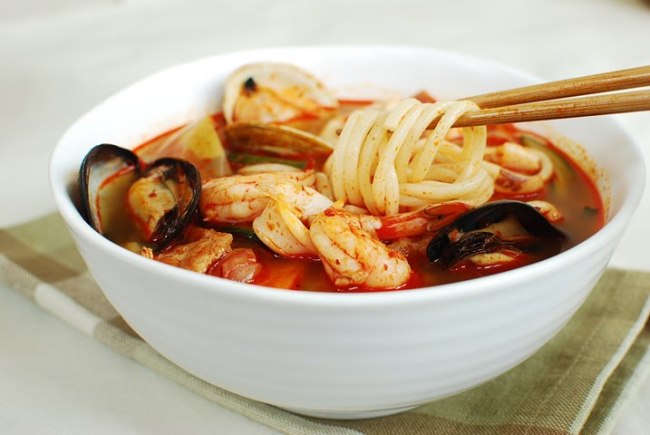 |
| Jjambbong (spicy noodle soup) (Korean Bapsang) |
You will find it surprisingly easy to make this popular bowl of noodle soup at home with easy-to-find ingredients. Restaurants usually use hand-pulled noodles, but for home cooking you can use ready-made fresh noodles sold in the refrigerator section of the store. The soup is typically made with chicken stock for a rich flavor, but you can also use anchovy broth for a cleaner/lighter taste. This soup also incorporates pork, chili-infused oil, and various vegetables and seafood. The combination of all the natural ingredients creates a hearty bowl of soup that is packed with robust flavors.
Ingredients: (2 servings)
● 400 grams fresh jjajangmyeon/udon noodles
● 1 thumb-size ginger piece, julienned
● 2 scallions, roughly chopped
● 1 tablespoon gochugaru (Korean chili pepper flakes) (adjust to taste)
● 1 tablespoon vegetable or canola oil
● 1 tablespoon soy sauce
● 100 grams fatty pork, thinly sliced
● 1/4 onion, thinly sliced
● 1/2 carrot, thinly sliced into bite sizes
● 1/2 zucchini, thinly sliced into bite sizes
●120 grams cabbage, cut into bite sizes
● 2 dried shiitake mushrooms, soaked and thinly sliced
● 4 cups of chicken stock
or anchovy broth (or water)
● 4-6 littleneck clams
(or other small clams)
● 4-6 mussels
● 4-6 shrimp
● 80 grams squid, cut into small sizes
● Salt and pepper
Have a pot of water ready to cook the noodles. (Turn the heat on when you start cooking the soup ingredients. This way you can time it so that the noodles can be finished cooking at the same time the soup is ready.) While making the soup, cook the noodles according to the package instructions and drain.
Prepare all of the ingredients before you begin cooking.
Heat a wok or a large pot over high heat. Add the oil, ginger, scallion, gochugaru and soy sauce, and stir fry for a minute.
Add the pork, and stir fry until the pork is almost cooked, about 2 minutes.
Stir in the onion, carrot, cabbage, zucchini and mushrooms, lightly salt, and cook until the vegetables are slightly softened, about 2 minutes. Stir occasionally.
Pour in the chicken stock (or anchovy broth/water), and boil until the vegetables are completely cooked.
Add the seafood starting with the clams, which require more time to cook, followed by the mussels, shrimp and squid. Bring everything to a boil again, and cook until the shells have opened. Add salt and pepper to taste.
Place a serving of the noodles in a large soup bowl and ladle the soup on top. Serve immediately while piping hot.



